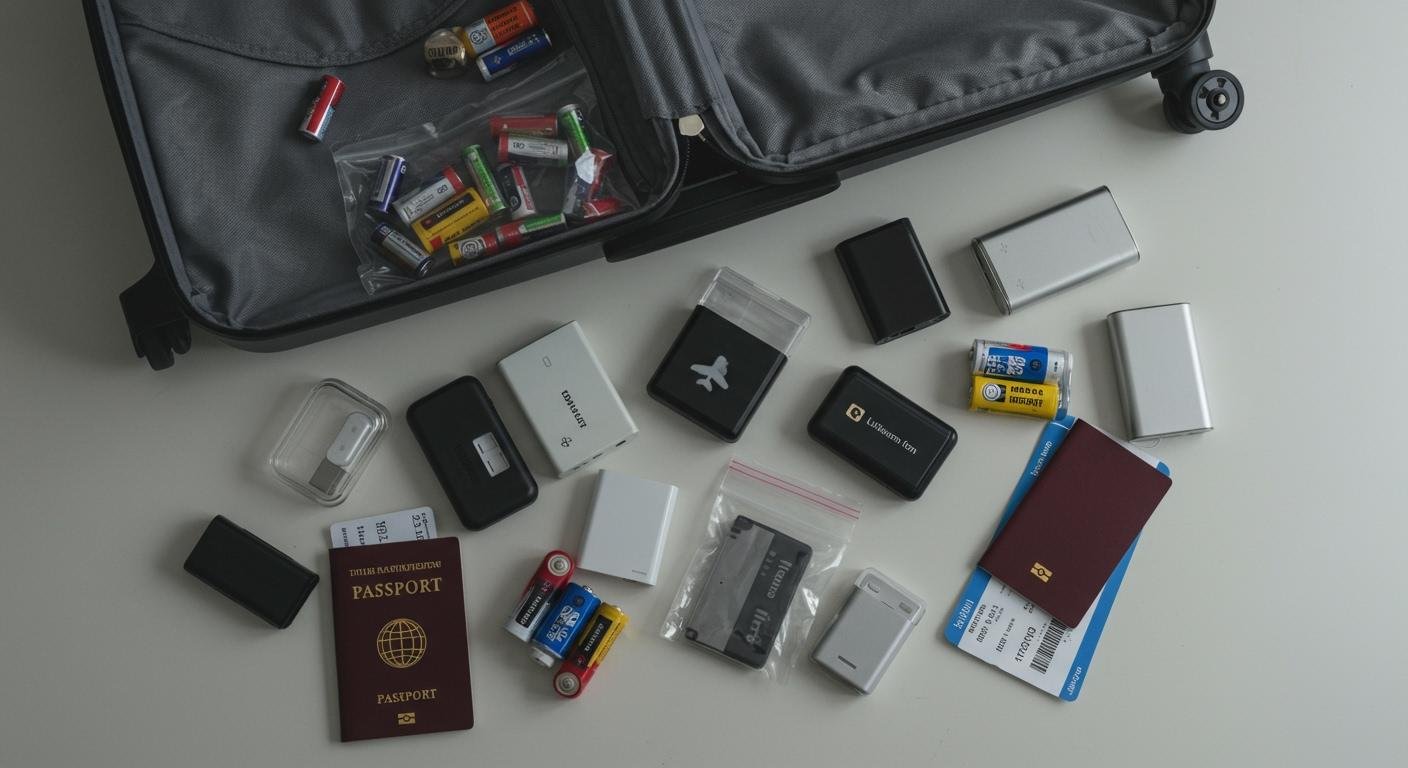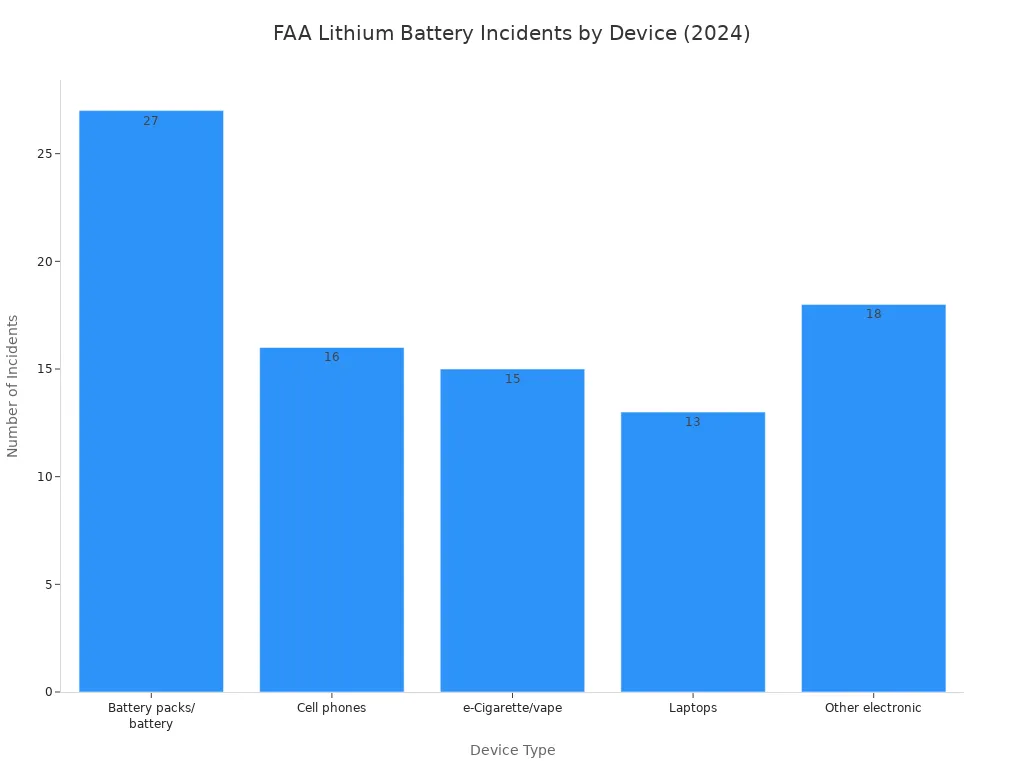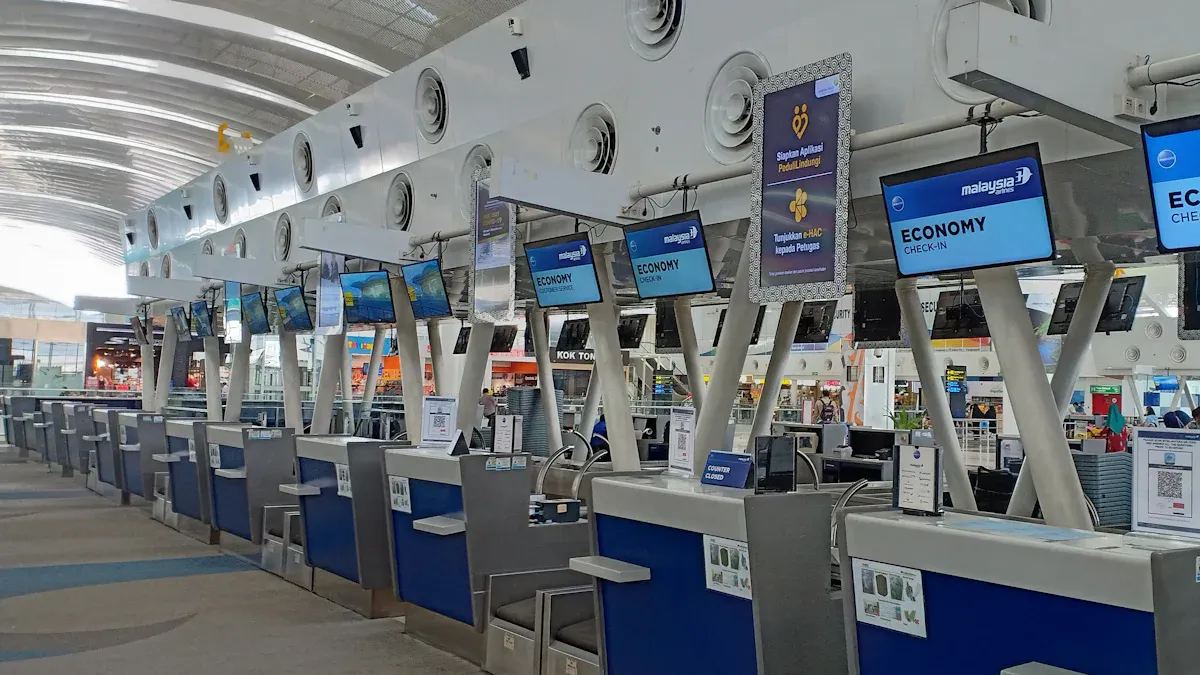
You must place all spare lithium batteries and power banks in your carry-on bag. This is the most critical rule for air travel. These powerful lithium batteries can cause a dangerous fire if their terminals short-circuit. The FAA tracks these events, reporting 89 incidents involving lithium batteries on aircraft in 2024.
FAA Incident Report: 2024 The data below shows that battery packs are a leading cause of these hazardous events.

Learning how to safely pack batteries is essential for the safety of all involved and helps you travel safely.
Understanding the Rules for Lithium Batteries
Air travel safety rules depend on a battery’s power capacity. This capacity is measured in Watt-hours (Wh). International Dangerous Goods Regulations require you to know the Wh rating of your lithium batteries before you fly. This helps you follow the correct packing procedures. Both lithium-ion batteries (rechargeable) and lithium metal batteries (non-rechargeable) are subject to these safety regulations.
Calculating Your Battery’s Watt-Hours
You can usually find the Watt-hour rating printed directly on your battery. For lithium-ion batteries made after December 31, 2011, the Wh rating should be clearly marked. If you cannot find it, check the product’s documentation.
You can also calculate the Watt-hours yourself if you know the Volts (V) and Amp-hours (Ah). Use this simple formula:
Volts (V) x Amp-hours (Ah) = Watt-hours (Wh)
Many batteries list capacity in milliampere-hours (mAh). You must convert mAh to Ah before calculating. Simply divide the mAh value by 1,000. For example, a 20,000 mAh power bank is 20 Ah.
The Three Tiers of Power Limits
Air transport regulations divide lithium batteries into three categories based on their power. These rules apply to both lithium-ion batteries and lithium metal batteries. The Dangerous Goods Regulations are designed to manage the risks associated with powerful lithium batteries.
| Battery Size (Wh) | Rule Summary |
|---|---|
| 高达 100 Wh | You can bring multiple lithium batteries for personal use. |
| 101-160 Wh | You need airline approval. You are limited to two spare lithium batteries per person. |
| Over 160 Wh | These large lithium batteries are forbidden in passenger baggage. |
💡 Tip for Mobility Aids An important exception exists for lithium-ion batteries that power wheelchairs. You may carry a battery up to 300 Wh, or two spares up to 160 Wh each, with airline approval. You must follow specific instructions for removing and protecting the battery terminals.
Always check your airline’s specific policies. Following these safety rules ensures a smooth and safe journey for everyone.
Carry-On vs. Checked Bag Rules

You must know where to pack your batteries. The rules for carry-on and checked bags are very different. Following these regulations is not just about avoiding delays at security. It is a critical step to prevent in-flight fires and ensure everyone’s safety. The location of your lithium batteries on the aircraft directly impacts risk management.
Carry-On: For All Spare Batteries
You must pack all spare lithium batteries in your carry-on luggage. This rule is strict and has no exceptions. Spare lithium batteries include items you might use every day.
- Power banks
- Portable chargers
- External batteries for cameras or laptops
- Cellphone battery charging cases
These items are forbidden in your checked luggage. If security screeners find spare lithium-ion batteries in a checked bag, they will remove them. You must keep these items with you in the aircraft cabin. This allows the flight crew to quickly respond if a battery overheats or catches fire.
Gate-Check Alert ✈️ An airline might require you to check your carry-on bag at the gate. You must remove all your spare lithium-ion batteries and power banks before handing over the bag. Keep these items with you on the plane.
Certain powerful or damaged lithium batteries are not allowed on the plane at all. You cannot bring them in your carry-on or checked bags.
Forbidden Batteries:
- Damaged, defective, or recalled lithium batteries
- Automobile, boat, or aircraft batteries
- Any lithium-ion battery over 160 Wh
- Smart bags with non-removable lithium-ion batteries
Checked Bags: For Installed Batteries Only
You can pack electronic devices with installed lithium-ion batteries in your checked luggage. This includes laptops, tablets, and cameras. However, you must take specific safety precautions. A fire in the cargo hold is much harder to detect and extinguish than one in the cabin.
You must power down any device completely before placing it in a checked bag. Do not use sleep or hibernate mode. A device in sleep mode can still turn on, generate heat, and cause a fire through a process called 热失控. You must also protect the device from accidental activation. Pack it securely between soft clothes to prevent it from being crushed or its power button from being pressed.
The rules for different battery types can be confusing. Use this table as a quick reference.
| 电池类型 | Carry-On Luggage | Checked Luggage |
|---|---|---|
| Spare Lithium Batteries | ✅ Allowed | 🚫 Forbidden |
| Installed in Device | ✅ Allowed | ✅ Allowed (Device must be OFF) |
| Non-Spillable (≤100Wh) | ✅ Allowed (Limit 2 spares) | ✅ Allowed (Device must be OFF) |
Always make sure your devices in checked bags are fully off. This simple step significantly reduces the risk associated with packing lithium batteries.
How to Safely Pack Batteries for Protection

You know that spare lithium batteries must go in your carry-on. Now you must learn how to protect them. Packing your batteries correctly is a mandatory step. It prevents short circuits that can lead to dangerous thermal runaway incidents.
Why Terminal Protection Is Mandatory
A battery’s metal terminals are where its energy flows out. If these terminals touch another metal object, like keys, coins, or even another battery, it creates a short circuit. This is the single largest preventable problem that can cause lithium batteries to overheat and catch fire. The resulting fire hazards are extremely serious on an airplane.
Ignoring these rules has led to tragedy. Investigators believe that improperly shipped lithium batteries likely contributed to several cargo plane crashes, including:
- Asiana Airlines 747 near South Korea (2011)
- UPS 747 in Dubai, UAE (2010)
- UPS DC-8 in Philadelphia, PA (2006)
In another incident, an airline captain discovered heavy smoke pouring from the cargo hold before takeoff. Emergency crews found that a fire had destroyed multiple lithium batteries inside a passenger’s checked bag. An electrical short started the fire. These events show why you must take every precaution. Protecting terminals is a critical safety measure to prevent a fire and avoid dangerous thermal runaway incidents.
Approved Packing Techniques
You can easily and safely pack batteries using several TSA-approved methods. These techniques create a barrier around the terminals. This barrier stops them from making contact with metal and helps reduce fire risk. You should use one of these methods for all your spare lithium batteries, including common alkaline and rechargeable lithium-ion batteries.
| Packing Method | 说明 | 最适合 |
|---|---|---|
| Original Packaging | Keep the battery in its original retail blister pack or box. | New, unused batteries. |
| Battery Case | Place batteries in a dedicated plastic or hard-sided case. | All battery types, especially for frequent travelers. |
| Plastic Bag | Put each battery in its own separate, sealed plastic bag. | A simple, low-cost option for any battery. |
| Tape Terminals | Cover the battery’s metal contacts with non-conductive tape. | Odd-shaped batteries or when other options are not available. |
When you choose a battery case, look for one with a durable, aerospace-strength construction and custom foam inserts. The best cases meet air transportation standards (like UN/IATA compliance) to protect your lithium-ion batteries from impact.
If you use tape, choose a non-conductive type like electrical tape. Make sure the tape is clear or does not cover up the battery’s Watt-hour rating or other identifying marks. This simple step helps you properly and safely pack batteries. Following these guidelines will significantly reduce fire risk from your lithium batteries and prevent potential thermal runaway incidents.
Special Tip for LiPo Batteries 🚁 Lithium Polymer (LiPo) batteries, often used for drones and RC cars, need extra care. You must use electrical tape to completely cover the main power plug and the smaller balance terminal. For an added layer of protection against thermal runaway incidents, place the taped LiPo batteries inside a fire-resistant LiPo-safe bag. This is the best way to safely pack batteries of this type. These powerful lithium-ion batteries demand the highest level of caution to prevent thermal runaway incidents.
A Note on Shipping Lithium Batteries
You might need to mail a device or a spare battery. The process for shipping lithium batteries is completely different from carrying them on a plane. The rules are much stricter because of the risks involved in unattended cargo. Understanding these differences is key to a successful lithium battery shipment.
Passenger Travel vs. Cargo Shipments
The rules for shipping lithium batteries as cargo are not the same as for your personal baggage. The International Air Transport Association (IATA) has specific dangerous goods regulations for this process.
- Aircraft Ban: You cannot send standalone lithium batteries or lithium metal batteries on passenger aircraft as cargo. These items must fly on “Cargo Aircraft Only” planes.
- Charge Limit: When shipping lithium batteries, they must have a state of charge no higher than 30%. This rule does not apply to the batteries you carry with you on a flight.
- Packaging Rules: The dangerous goods regulations for a lithium battery shipment are very detailed. They cover everything from labeling to the type of box you can use.
Following the correct procedure for shipping lithium batteries is a legal requirement. These strict rules help manage the unique risks of transporting lithium batteries and lithium metal batteries by air.
Certification and Special Packaging
You cannot simply put lithium batteries in a box and mail them. The process of shipping lithium batteries requires special knowledge and handling.
Did You Know? 🧐 Shippers, freight forwarders, and airlines must complete mandatory training to handle the shipping of lithium batteries. IATA offers a “Shipping Lithium Batteries by Air” course to ensure everyone follows safety protocols.
All lithium batteries must pass a difficult testing standard called 联合国 38.3 before they can be shipped. These tests simulate the harsh conditions of transport, including vibration, shock, and extreme temperatures. The packaging itself must also meet strict criteria. You must place batteries in non-metallic inner packaging and secure them to prevent any movement during transit. These dangerous goods regulations ensure the safe shipping of lithium batteries.
You can now safely pack batteries for your next trip. Many travelers make mistakes, like putting power banks in checked bags or not knowing the rules for powerful lithium batteries. Use this final checklist to avoid common errors and prevent a potential fire.
- Carry-On Only: You must place all spare lithium batteries and power banks in your carry-on luggage.
- Check Power: You need airline approval for lithium batteries between 101-160 Wh.
- Protect Terminals: You must protect all spare lithium batteries from short circuits.
- Power Down: You must turn devices in checked bags completely OFF.
When in doubt, always contact your airline before you fly. They can provide specific rules for your lithium batteries.
常见问题
What about regular alkaline batteries?
You can pack alkaline batteries (like AA or AAA) in both carry-on and checked bags. You should still protect the terminals to prevent a short circuit. Placing them in their original packaging or a battery case is a good practice.
Can I bring my smart bag with a built-in charger?
You can bring a smart bag if its lithium battery is removable. You must remove the battery before checking the bag. Then, you carry the battery with you in the cabin. Bags with non-removable batteries are forbidden on most airlines.
How many power banks can I bring?
You can bring multiple power banks under 100 Wh for personal use. Airlines do not set a specific number. However, a large quantity may be questioned. For power banks between 101-160 Wh, you are limited to two with airline approval.
What happens if I leave a battery in my checked bag?
TSA screeners will likely find the battery during inspection. They will remove the item from your bag. This process may delay your luggage. In some cases, the airline might hold your bag at the departure airport for you to retrieve.

